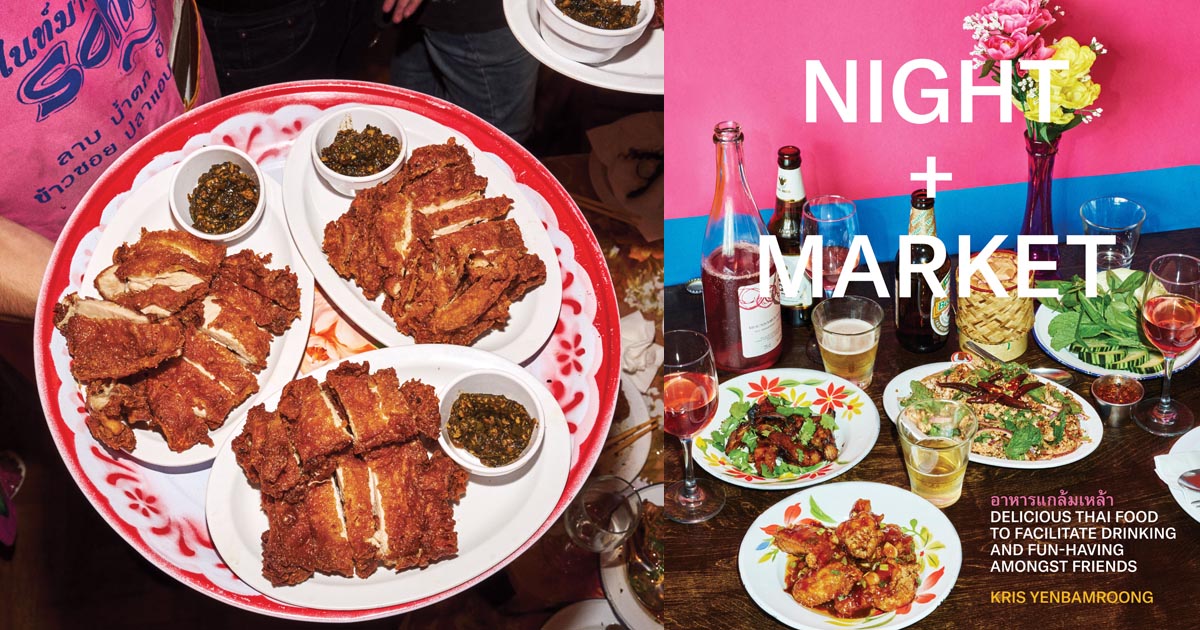CHIANG RAI FRIED CHICKEN
GAI TOD NAENG NOI – Serves 2 to 4
Reprinted from “NIGHT + MARKET: Delicious Thai Food to Facilitate Drinking and Fun-Having Amongst Friends” by Kris Yenbamroong with Garrett Snyder. Copyright © 2017 by Kris Yenbamroong. Photographs by Marcus Nilsson. Foreword by Andrew Ricker. Published by Clarkson Potter/Publishers, an imprint of Penguin Random House LLC.
I think a lot about the great fried chickens of the world: Southern pan-fried chicken, Japanese karaage, Korean double-fried chicken, Popeyes, etc. In Northern Thailand, the gold standard of fried chicken is the kind you’ll find at market stalls, where vendors sell crispy chicken quarters bundled up in banana leaves. The skin actually gets crunchier the longer you let it sit, which is partly why you can roll it up to go, drive it home on your motorbike, and it will still be crunchy hours later.
I procured my fried chicken recipe from a family who I feel makes the best fried chicken in Chiang Rai, and although they wouldn’t give me their entire recipe, they let me know enough to put the puzzle pieces together.
The secret is a mixture of different flours and club soda, a watery batter that produces a super-crunchy crust without soaking up too much oil. The soda water is technically a substitute for hydrolyzed limewater, which is called nam poon sai in Thai, but the two are interchangeable in my experience. The batter itself isn’t heavily seasoned—instead you’ll be relying on brining the chicken beforehand, which will give it a garlicky flavor and ensure it stays indecently juicy.
At the restaurant I use boneless chicken thighs because they’re easier and more enjoyable to eat. If you prefer to use bone-in chicken, that’s fine too. Let your raw chicken come to room temperature before frying, and once you’ve taken the thighs out of the oil and drained them on paper towels for a few minutes, use a knife to make a small incision under the non-skin side to see if it’s done to your liking. If not, put it back in the fryer for another minute, and then check again before slicing into strips.
4 (6-ounce) skin-on, boneless Brined Chicken thighs
1¼ cups tempura flour or tempura batter mix
⅓ cup tapioca flour
⅓ cup white rice flour
1 teaspoon kosher salt
1 teaspoon ground white pepper
3 cups club soda
Vegetable oil, for deep-frying
Good fried chicken is even better with a dipping sauce. Serve this with either nam prik noom or Ranch Dressing , or both.
Remove the chicken from the refrigerator, drain, and let come to room temperature, about 30 minutes. Use a paring knife to score the non-skin side of the thighs to help them cook faster and more evenly.
In a medium bowl, stir together the tempura, tapioca, and rice flours, and the salt and pepper. Pour in the soda water. Use your hands to mix thoroughly until no lumps are left. The batter should be thinner than pancake batter.
Pour 3 inches of oil into a wok, Dutch oven, or heavy-bottomed pan with several inches of clearance and heat over high heat to 350°F. (Throw in a grain of uncooked rice or a fleck of batter; if it pops up and starts sizzling right away, the oil is ready. Or use a thermometer.) Dunk each thigh in the batter until coated, then quickly transfer to the hot oil. Working in batches if necessary, fry the thighs until the crust turns a deep amber color, 6 to 7 minutes, flipping once halfway through. Remove the chicken and let cool on a wire rack or paper towels. (You can make a small cut on the non-skin side to make sure it is cooked through if you want.) Slice each thigh into ½-inch-wide strips and serve with ranch dressing or nam prik noom.
BRINED CHICKEN
Makes 1½ pounds
About 90 percent of the chicken we use at Night + Market is brined ahead of time—the exceptions being ground chicken or any chicken that has its own marinade (like Cashew Chicken, page 49, or Thai Boxing Chicken, page141). We use chicken thighs, because in my opinion dark meat is more delicious and it retains moisture better. We take the time to brine because it means having flavor built-in before you start cooking, which is a tremendous advantage, especially when it comes to quick cooking techniques like stir-frying. Brining your chicken not only adds complexity, it keeps the meat moist too. If you don’t plan on cooking the chicken right away, I’d suggest draining off the brine liquid once marinated and storing the thighs in the fridge until you’re ready to use them.
1½ pounds boneless, skin-on chicken thighs (4 to 6)
1 tablespoon minced garlic
1 tablespoon minced lemongrass
½ tablespoon kosher salt
½ teaspoon ground white pepper
Place the chicken in a large bowl, plastic storage container, or large zip-top bag. Sprinkle on the garlic, lemongrass, salt, and white pepper and add enough cold water to cover.
Mix until the seasonings are dissolved and let marinate at room temperature for at least 15 minutes and up to 30 minutes; any longer and the chicken can become too salty. Pour off the liquid and keep the chicken refrigerated until ready to use.
In 2011, Kris Yenbamroong launched a pop-up in a former dry-cleaning space next door to Talésai, a small restaurant on the Sunset Strip that his parents had owned and operated his entire life. Craving more spice, more sour, and more funk, Kris’s quirky, somewhat haphazard project was dubbed Night + Market. Its specialty was natural wine and Thai drinking food. Two restaurants and countless accolades later, the avant-garde cooking of a kid who went to NYU film school has transformed the way an entire city thinks about Thai food.
Featuring more than 100 recipes and photographs, Night + Market: Delicious Thai Food to Facilitate Drinking and Fun-Having Amongst Friends is a deep dive into the mind of chef Kris Yenbamroong and his unconventional perspective on cooking. Inspired equally by his grandmother’s steamed dumplings, obscure varieties of larb found on motorcycle trips through Chiang Rai, and ranch-slathered burgers from late-night LA diners, the cooking of Night + Market is informed by authenticity but not bound by it. Instead, readers are invited into a world where the techniques and flavors fundamental to Kris’s style are explained with both words and photos in a way that can’t help but spur the home cook into action.
With chapters that explore and analyze the basics of Thai cooking and the classic dishes and techniques from the heart of Thailand, the culture of Thai drinking food, and Kris’s evolving view on what makes food authentic, Night + Market embodies the idea that food should be delicious enough to jolt awake the senses, and addictive enough to associate certain tastes with loud music and good friends and a party that never really starts or ends.
Kris Yenbamroong is chef-owner of the Night + Market restaurants in Los Angeles. He was named Best New Chef by Food & Wine magazine in 2016.
 |
 |






